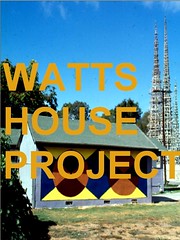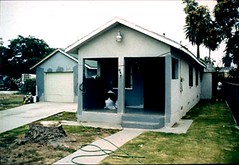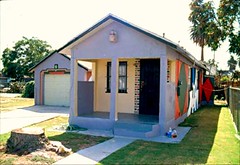Amazing community art & development projects (part 2 of 2: LA's Watts House Project)

Posted November 10, 2008 at 4:44PM
Last time, I wrote about the wonderful Project Row Houses in Houston. Today I get to write about its progeny, the Watts House Project in south Los Angeles.
PRH founder Rick Lowe attempted to replicate his Houston project in Los Angeles, in the shadow of the famous Watts Towers, built in the 1920s by Italian immigrant Simon Rodia and probably the most impressive work of folk art I have ever seen. But he was unable to pursue the project from Houston, and the idea languished until it was taken up by LA native Edgar Arceneaux, who began renovation work at a launch event coordinated with the Watts Jazz Festival in September.
His goal, according to the website of the Watts House Project, is "to work directly and collaboratively with the residents of [south LA's] 107th Street, along with local architects and designers, to completely overhaul the neighborhood with gorgeous facade enhancements and streetscape improvements, all smartly and ecologically designed to meet the particular needs of the residents themselves." Not a bad start, that.
(Apart from the Watts Houses, Arceneaux's work is widely acclaimed and shown. His work has been exhibited at the San Francisco Museum of Modern Art, The Kitchen in New York and Studio Museum in Harlem, and the Hammer Museum in Los Angeles, among many others in the US and abroad. He was also honored by selection for the prestigious Whitney Biennial in New York in 2008.)
The Watts project's website goes on to note that Arceneaux has been developing personal relationships with many of the block's residents, knocking on doors and initiating conversations. During a presentation at a neighborhood meeting, he marveled at the collaborative sharing of resources that already occurs informally throughout the neighborhood, with many of the residents sharing their formidable craft, construction, and artistic skills freely. These include a metalworker with a welding shop in his backyard, a family of roofers, skilled construction workers, gardeners, chefs, and artists. Arceneaux hopes the Watts House Project can help mobilize these existent resources in a focused and systematic way that can bring innovative change throughout the neighborhood.
 One of the goals is to empower the residents with skills and assets that will enable them to capitalize on the enormous cultural capital of the Watts Towers and the 250,000 tourists a year that they draw. For example, one resident has mentioned her interest in a community-run café or souvenir shop, which Arceneaux says is just the kind of thing that the Project wants to catalyze.
One of the goals is to empower the residents with skills and assets that will enable them to capitalize on the enormous cultural capital of the Watts Towers and the 250,000 tourists a year that they draw. For example, one resident has mentioned her interest in a community-run café or souvenir shop, which Arceneaux says is just the kind of thing that the Project wants to catalyze.
It's a terrific concept. Writing in the Los Angeles Times, Lynell George reports:
"The Watts House Project (WHP) -- part conceptual art, part activism -- is a mission that Arceneaux, its director, describes as 'an artwork in the shape of a neighborhood development' . . .
"Arceneaux wants to fold together the history of the neighborhood alongside the stories of its residents, pairing artists with architects, creativity with practicality. He hopes to get to all 20 structures on 107th Street -- refurbishing four a year for the next five years -- and expand to create exhibition spaces, cafes, gardens and artists residences. 'Instead of using clay, we're using time and space to sculpt a neighborhood and relationships.'"
 The University of Southern California's School of Architecture has been working with Arceneaux and the neighborhood on a master plan for art-driven revitalization that includes green architectural projects for the location of an artist-in-residency program, exhibition spaces, a café, communal house, daycare, educational programming, Project offices and affordable residential housing.
The University of Southern California's School of Architecture has been working with Arceneaux and the neighborhood on a master plan for art-driven revitalization that includes green architectural projects for the location of an artist-in-residency program, exhibition spaces, a café, communal house, daycare, educational programming, Project offices and affordable residential housing.
The Watts project, of course, has a long way to go before it can compare to Lowe's work in Houston. But it already seems to be inspiring pride in a community-driven neighborhood that could become a worthy creative and cultural match to Rodia's masterpiece.
Go here for a fabulous PowerPoint presentation explaining the project, or watch this great two-minute video to get some of the purposeful yet informal flavor of the project:

